#late-victorian era architecture
Text

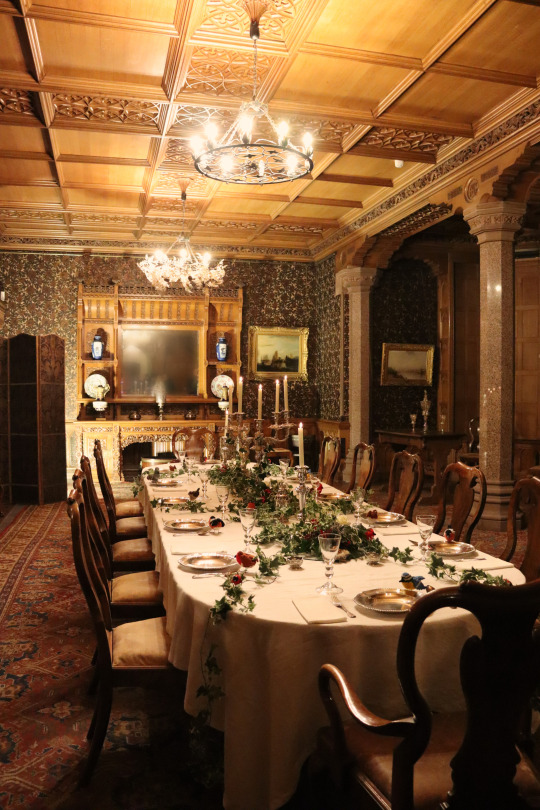




Victorian Christmas at Tyntesfield 🎄
#cottagecore#cottage core#cottage aesthetic#victorian#victorian era#edwardian#antique#1890s#1800s#tyntesfield#victorian aesthetic#victorian architecture#late 1800s#victorian age#19th century#christmas#christmas aesthetic#vintage#vintage style#dark academia#dark acadamia aesthetic#dark academism#art#architecture#victorian art#aesthetics#fairmaidnelly
785 notes
·
View notes
Text

Postcard photo of a cat by Ms. A.M. Nikodem. Chicago, 1880s.
#dark academia#light academia#classical#academia aesthetic#escapism#academia#books and libraries#classic literature#architecture#books#postcard#object#cat#victorian era#late 1800s#19th century#royal core#vintage#antique#violin#cottage core#aesthetics#mood#vibe#tumblr#photograph#chicago
128 notes
·
View notes
Text

A couple of tiny 1880's era remnant terrace houses/hovels that were somehow missed during the extensive slum clearances of the late 1940's-early 1950's. Now 'studio apartments'. Small public park at rear is where the rest of them once were. Glebe.
#vintage#tiny houses#1880's#slum#slum clearances#hovels#terrace houses#remnant#crumbling#it's#facade#late victorian era architecture#streetscape#inner west sydney
158 notes
·
View notes
Text
A Victorian-era young lady visits her secret love in his city to explore the grand buildings, cathedrals, and parks surrounding the printing press shop where he is employed. Tensions between them build slowly with each stolen moment in the shadows and every brush of the hand, until they abscond to a wooded park so that they might have the space to speak freely and get closer - in every sense.

#complete stories#rated m#naturecore#dark cottagecore#victorian era#late victorian era#tea#dark academism#cottage aesthetic#cathedral#creative writing#star crossed lovers#love#english countryside#slow build#one shot#short story#pining#library#historic architecture#edwardian#aesthetic#escape#flirty#tension#kissing#steamy#longing#light acedemia#dark acedemia
11 notes
·
View notes
Text
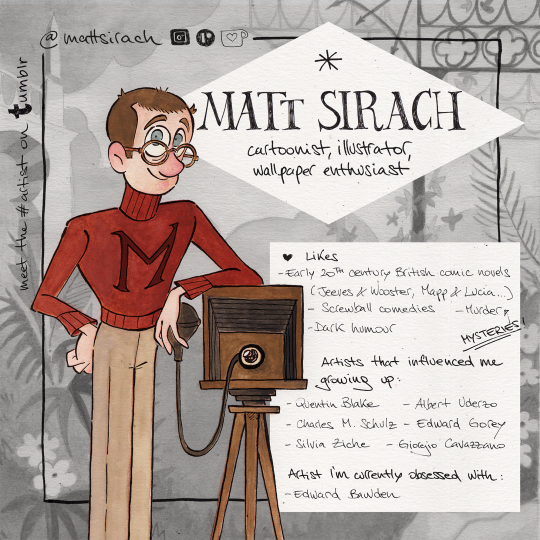
Meet the Artist: @mattsirach
Hello there! My name is Matt Sirach, and I’m an illustrator, cartoonist, and designer with a degree in Architecture and a passion for wallpaper.
I’ve been afflicted since childhood with a particularly stubborn case of Anglophilia—we’ve tried everything from bloodletting to mesmerism—yet it keeps inevitably influencing my art and taste.
Most of—if not all—my illustrations are set in a timeframe ranging from the late Victorian Era to the 1930s: I like the clothes, I like the interiors, I like the graphics and the design, and I find the societal affectations of that time endlessly amusing.
I gravitate towards humor and comedy always—even when I design wallpapers—and I like my illustrations to be dynamic and tell a story in the most succinct way possible.
I work mainly traditionally—with nibs, ink, watercolors, and gouache—with a bit of digital enhancement.
Nice to meet you, Matt! Below are some pieces he has shared with you all.
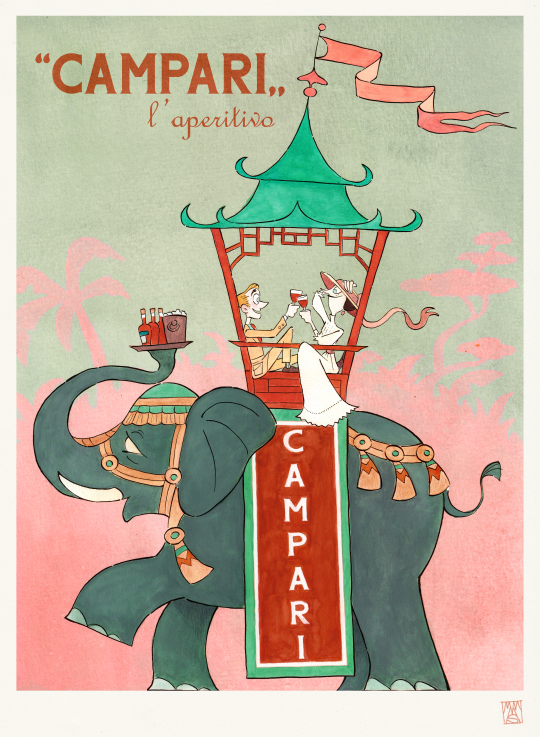
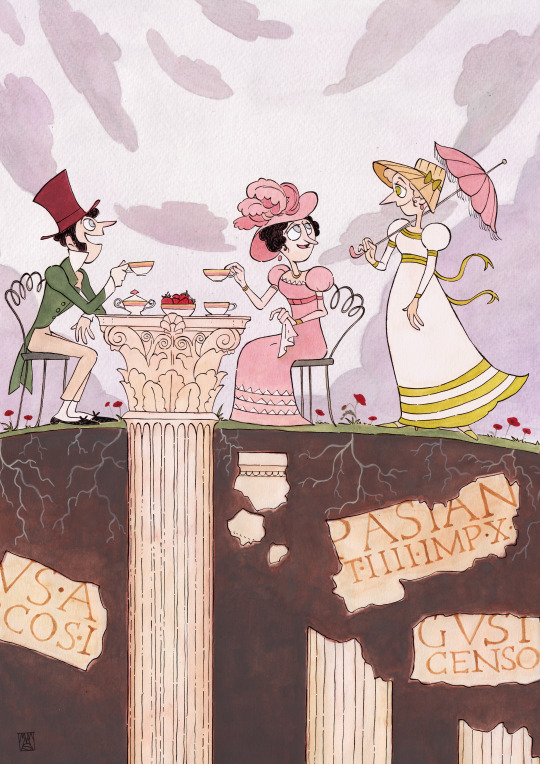

Check out more of Matt’s work over at his Tumblr, @mattsirach!
912 notes
·
View notes
Text
Probably a clue to the cult that kidnapped the twins
Ok, this is my first post here and I don't know much about English so I'll use the translator.I hope that a part of kurofandom can see this and tell me what they think.
A few days ago I started rereading the twin reveal arc manga, and since lately I've been doing research on gothic/medieval architecture, I saw this panel from chapter 135 and thought "this castle seems to be medieval".
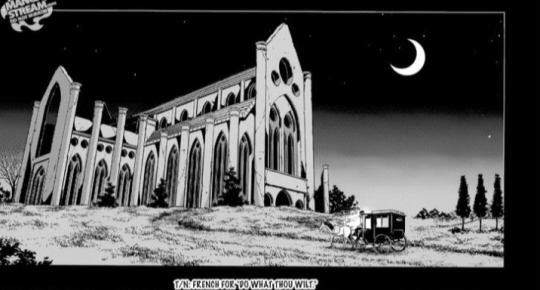
then the idea of looking for information on satanic sects during the Victorian era occurred to me, and although in reality there was very little information about it, after searching for a while I finally found a page that told me about what I was looking for.

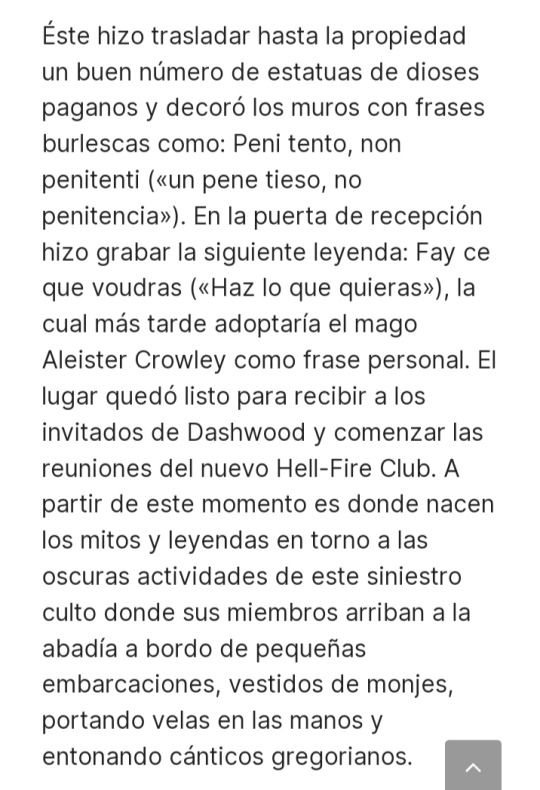



Well this information is about a man named Sir Francis Dashwood, like many of the young people of Victorian England who prided themselves on being part of blue blood families, he was an inexhaustible traveler. He toured almost all of Europe as part of his training, but he always expressed a very marked passion for Italy. Dashwood was a man of the world, surrounded by powerful friends in politics, banking and the art world. He held important positions in the civil service of England. He was also a notable lover of parties, music, food, drink and women in large quantities, in addition to art and Greco-Roman cultures. Quite a character with notable influences that he had access to practically what he wanted. He lived near the River Thames, in Buckinghamshire, in a huge mansion in West Wycombe, surrounded by luxuries and servants who fulfilled any mandate 24 hours a day. In it he held meetings with notable friends of his and members of Masonic lodges in which his vices surfaced permanently.
However, he had in mind the creation of a select secret group in which he could discuss freely about political and philosophical issues exclusively, made up of elegant and influential gentlemen from English high society. This is how he found the ideal place to carry out these meetings: Medmenham Abbey, whose owners were members of the Duffield family, and which was about five kilometers away from his mansion. The Duffields agreed to rent the property, erected around 1200 by a congregation of Cistercian monks. The place was perfect in every way: away from prying eyes and with an atmosphere of mysticism, thanks to its medieval air that enchanted Sir Francis.
He had a good number of statues of pagan gods moved to the property and decorated the walls with mocking phrases such as: Peni tento, non penitenti ("a stiff penis, no penance"). On the reception door he had the following legend engraved: Fay ce que voudras (<< Do what you want »), which would later be adopted by the magician Aleister Crowley as his personal phrase. The place was ready to receive Dashwood's guests and start the meetings of the new Hell-Fire Club. From this moment is where the myths and legends are born around the dark activities of this sinister cult where its members arrive at the abbey aboard small boats, dressed as monks, carrying candles in their hands and singing Gregorian chants.
It should be clarified that in reality the cult called themselves "The Monks of Medmenham". The name "Hell-Fire" club was more of a derogatory nickname.
So reading all this information I realized something, the phrase that this cult used was "fray ce que voudras" which means "Do what you want" or "Do your will" and this same phrase is used by the members of the cult that kidnapped to the twins.
In this part of chapter 135.
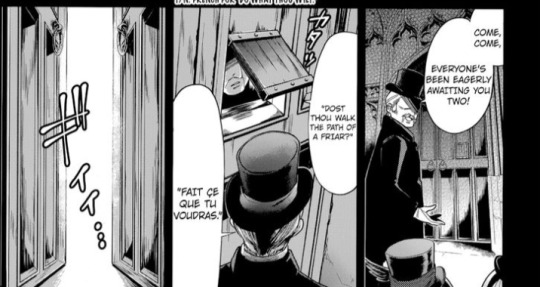
here I realized that when they arrive at that castle the receptionist asks "are you a monk?" To which the other responds with "Fay ce que voudras" (Do what you want). The same phrase used by members of the cult The Monks of Medmenham.
So I would assume that this is a hint that Yana left us and I don't see anyone else talking about it. I don't know if so many people from kurofandom follow me but tell me what you think about this, we should investigate further but I think this is a very obvious clue. 😸
#black butler#Kuroshitsuji#ciel phamtonhive#sebastian michaelis#No sé qué más agregar pero porfavor leanlo#kuroshitsuji theory
220 notes
·
View notes
Text
I am never not thinking about The Haunting of Hill House and midcentury antipathy towards Victorian architecture and interior design
but lately my thoughts on it have been stirred up on learning that Shirley Jackson didn't exactly hate old houses. both of her houses in North Bennington, Vermont were 19th-century; the latter firmly within the late Victorian style that was unloved in the 1950s even as the former's Empire/Federal look was somewhat better appreciated

I suppose these feelings can coexist- and her home was hardly equal to the more extreme, lavish houses built by her great-great-grandfather's architecture firm in San Francisco. her mother, in a very midcentury moment, included a note with an inspiration photo of the Crocker House that said "glad [it] didn't survive the earthquake"
whether Jackson agreed with this sentiment, I haven't read enough of her personal papers and biographies to know. but my assessment of her feelings and how they're reflected in HoHH is sort of shifting from "disgust" to "mingled disgust and fascination?" maybe? we'll see how I feel upon delving into it futher
(certainly that jives with how, while people in the 1950s often despised Victorian houses, they populated their horror stories and Haunted House media so thickly with them that we still go back to the Victorian era for our own image of creepy things)
I'm starting to wonder if this author, who quietly encouraged the people in her town to believe that she was a witch, identified somewhat with Hill House itself as much as any of the human characters in the story
95 notes
·
View notes
Text
I think I know why Tessa family’s house had a Victorian style and activity’s every though there in the future
The architecture of the family mansion is reminiscent of late 19th early 20th century. This correlates to Le belle époque witch means the Beautiful era.
So basically this was the best time to be wealthy
This was a time for innovation but most of the time only the super wealthy could reap the befits where everyone one under them (in this context the drones) suffered with low wages and unsafe conditions.
One factor is how they treat Tessa +drones as they should be seen and not heard witch was common idiology to treat children And maidservants (the drones)
Basically Tessa’s families is in the upper class where they have so mutch money they can basically have a second le belle époque and they are simulatating the life in the late 19th early 20th Century probably with other families.
Hence that the gala was a way to tighten relations with other welthy folk;the family seems a lot more strict with following the style than other ;like with the one person commenting on how James talks.
I think le belle époque was a hay day for the family if there was previous generational wealth or made it big during the time that led the current family to have all the money accrued from overtime.
Edit: This correlates to the fact that children where desired in the workforce at the time because they would behave more and could be paid less,this is similar to the worker drones and there child like behavior and also n telling v “she a kid just like us” implying there younger; so the worker drones representing the lower class and getting “ employed ” at a young age and getting retired after a while  just like the shorter lifespan as low class child laborers.
90 notes
·
View notes
Photo
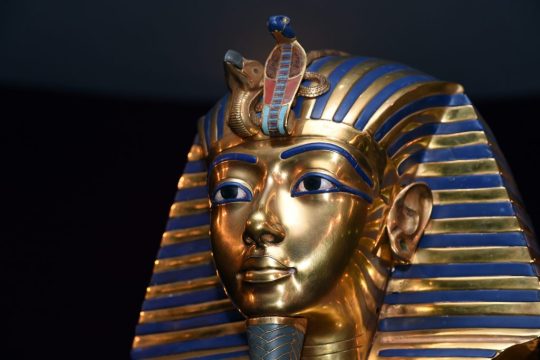
The 5 Most Opulent Artifacts Found in King Tut’s Inner Tomb
All that glitters is sometimes gold—particularly when it comes to the tomb of King Tutankhamun.
There is perhaps no other period in human history that has captured minds and imaginations quite like ancient Egypt. “Egyptomania,” or the intense interest in all thing Egypt, was first sparked by Napoleon’s Egyptian Campaign at the turn of the 19th century. Throughout the 1800s, people across the world emulated the architecture and design of Egyptian culture—for example, Victorian-era jewelry frequently incorporated scarabs, and cartouches and monuments across Europe took the form of obelisks.
The pervasive obsession with Egypt reached an apogee when on November 26, 1922, archaeologist Howard Carter and his team discovered the doorway to the tomb of Pharaoh Tutankhamun (commonly referred to as King Tut) in the Valley of the Kings on the west bank of the Nile. Though archaeological digs had been undertaken throughout the area, most tombs had succumbed to looting and grave robbing, leaving them stripped bare of their original contents. Tut’s tomb, however, had been hidden by debris and rubble, preserving it to near perfect condition.
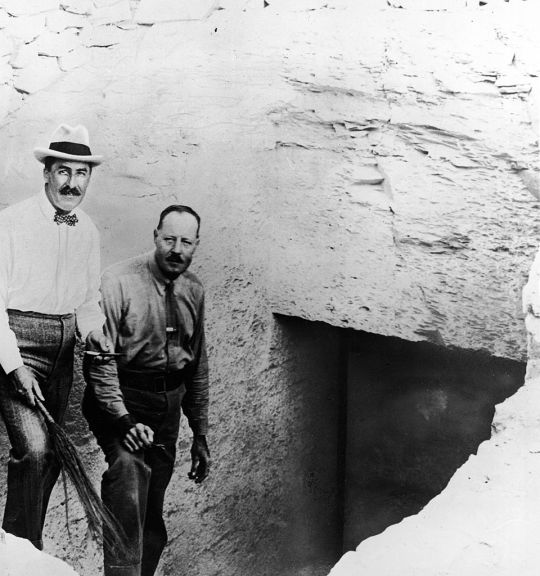
Despite discovering King Tutankhamun’s tomb in late 1922, it took several months for archaeologists to work their way through and catalogue the contents within the outer chambers. On February 16, 1923, Carter finally came face-to-face with the doorway leading to the tomb’s inner burial chamber and unsealed it. What he and his team were met with was the most well-preserved and intact pharaonic tombs ever found. Over the following eight years, the items and goods contained therein were carefully catalogued and removed, and today are held in the collection of the Egyptian Museum in Cairo.
To mark the centennial of the unsealing of the burial chamber, we’ve gathered five of the most opulent and intriguing artifacts that were found in King Tutankhamun’s tomb.
Tutankhamun’s Sarcophagus and Three Coffins:

Seeing the sarcophagus was perhaps one of the most exciting moments for the archaeologists at the time, as it indicated early on that the contents were preserved and intact. Crafted of quartzite and red granite, and displaying the images of Isis, Nephthys, Neith, and Serqet, the sarcophagus housed three nesting coffins which held Tutankhamun’s mummified body. The outer two coffins are made of fully gilded wood and inlaid with glass and semiprecious stones, such as turquoise and lapis lazuli. The innermost coffin, however, is made almost entirely out of 110.4 kilos of solid gold, similarly adorned with inlaid stones, and incised with inscriptions and in the shape of Osiris holding scepter and flail.
The Death Mask of Tutankhamun

Found within the innermost coffin upon the mummified body, King Tut’s death mask has become a world-recognized icon of ancient Egypt and the pharaonic era. Composed of 10.23 kilos of solid gold, it depicts Tutankhamun wearing the traditional stripped pharaonic headdress replete with representations of the goddesses Nekhbet and Wadjet above his brow. The mask’s back and shoulders are inscribed in Egyptian hieroglyphs with a protective spell copied from the Book of the Dead, offering protection as the pharaoh moved through the underworld.
Canopic Shrine

In the process of mummification, many of the person’s organs are removed and placed in what are called canopic jars. These containers frequently included lids shaped after the heads of the Sons of Horus, protective deities. Like many other ancient Egyptian tombs, King Tut’s included an alabaster canopic chest containing the four separate jars. However, in the pharaoh’s tomb, these were housed in a canopic shrine. Standing at six-and-a-half feet tall and enrobed in gold, the shrine includes the figure of the goddess Nepthys who stands guard over the royal contents.
Golden Sandals
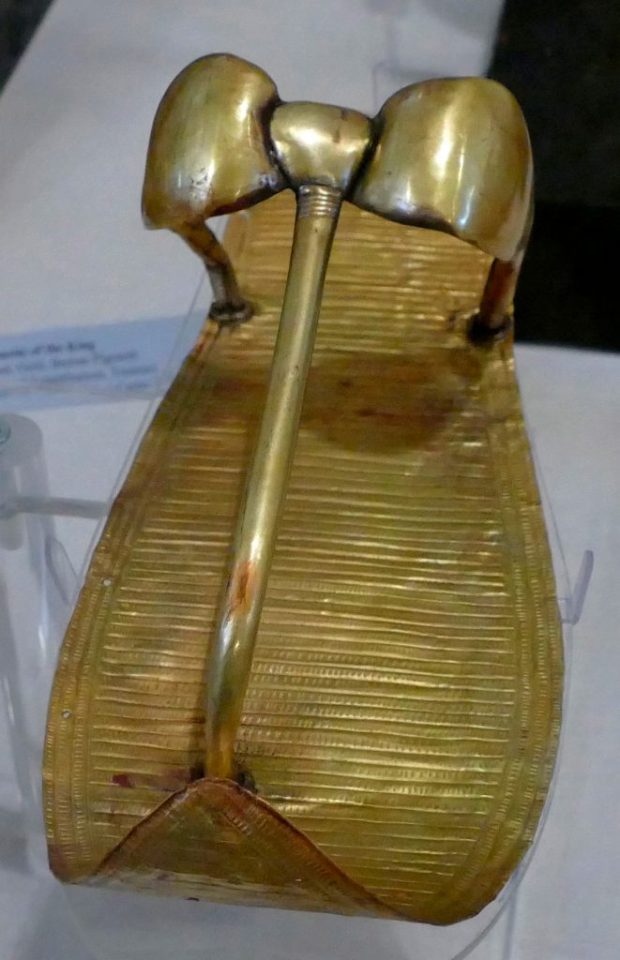
A large swathe of the items found in King Tutankhamun’s tomb represented personal necessities, such as clothing, toiletries like perfume, and food stuffs. Included among these items were a pair of gold sandals. These golden shoes have been found in numerous other ancient tombs, and it is believed that they were made specifically for funerary and burial practices. The soles of the shoes depict the nine traditional enemies of Egypt, including the Nubians and Libyans, symbolizing that as god-king they were literally beneath his feet.
Golden Chariot
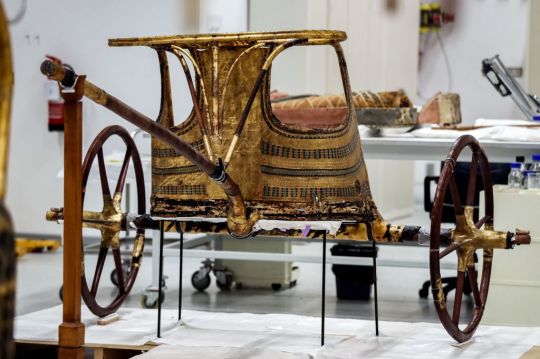
King Tutankhamun’s tomb contained a total of six golden chariots—though, unfortunately, all were in various states of disrepair as they were either mishandled or damaged by looters. After restoration, they were identified as typical D-cab chariots that were meant to be drawn by two horses. The image of a pharaoh driving a chariot was a common symbol of royal power and wealth, and in ancient times, pharaohs were often presented at public events in opulent chariots to highlight their status.
By Annikka Olsen.
#The 5 Most Opulent Artifacts Found in King Tut’s Inner Tomb#King Tutankhamun#Howard Carter#ancient tombs#ancient graves#ancient artifacts#archeology#archeolgst#valley of the kings#gold#treasure#history#history news#ancient history#ancient culture#ancient civilizations#ancient egypt#egyptian history#egyptian pharaoh#egyptian art
50 notes
·
View notes
Text
GOTH FASHION
For my fourth post I want to talk about an equally important aspect of Gothic culture/aesthetic. The outfits, the fashion, and the accessories!
Gothic fashion has spanned centuries. Specifically starting in the Victorian era. A surge in gothic fashion truly started because of the beginnings of gothic novels, gothic architecture and even gothic classical music happening with the late 1800s early 1900s.


As you can see from these two images, Victorian gothic fashion is absolutely gorgeous, playing heavily off of Victorian fashion, the garments themselves usually being in full black or a mixture of black or white. Playing into the darker aesthetics of gothic cultures.
A lot of the accessories themselves again play off of the chic victorian aesthetic, with tight lace, bodices and darker makeup.
I really enjoy this aesthetic because of how classy it appears, it’s especially a nice choice when you want to present more high fashion. Although, the garments themselves can be quite expensive.

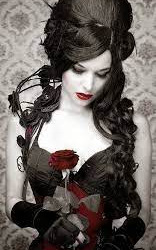
Another gothic fashion subgenre termed `Romantic Goth` is quite similar to the Victorian gothic iteration. Although the main stark differences are that the romantic aspect is entirely because this gothic sub-fashion started and takes direct inspiration from the romantic era. A Lot of people who dress in the romantic goth aesthetic, play heavily into the vampiric vibe.
I enjoy this subgenre of gothic fashion just as much as victorian goth, they both serve as similar yet different juxtapositions of one another. Although, both aesthetics can be quite hard to source and maintain unless you can find well made garments or know how to sew yourself.
Moving on to possibly my favourite gothic sub fashion of all time is the obvious Traditional goth, more commonly said as Trad- Goth for simplicity.
This gothic aesthetic arose in the early 80s right after goth music started becoming popular. People such as Siouxie Soux from Siouxie and the banshees, and Robert Smith from the cure show great examples of what traditional gothic fashion entails. White faces, exaggerated yet gorgeous contours, and black clothes! Reminiscent of industrial and clubbing scenes. Trad goth is easily accessible with thrifting, makeshifting, etc. Although the trad goth makeup is a plus, a lot of goths prefer to only wear the clothing pieces and not full makeup. (It takes forever to do without practice lol).
It’s interesting to note the similarities between trad goth makeup and corpse paint. Both styles include mainly white bases and heavy dark black makeup, usually coinciding with the ìdea of ‘trying to look dead’.


Another great sub fashion within the goth community is cyber-goth! Although I don’t know a ton about the history of the aesthetic itself, the outfits are wonderful and serve as great clubbing outfits. As the name suggests cybergoth takes a lot of elements from the cyberpunk aesthetic, including tons of bright colours (usually neons as shown in the picture down below). Although this aesthetic isn’t as popular as trad goth it’s super cool and super campy. I really like how cybergoth incorporates a lot of masks and headgear into the mix of their outfits.


Finally, I want to touch on the Nu-Goth aesthetic. As the name suggests, Nu means ‘new’ in this context. Nu-Goth is a much more modern take on the gothic aesthetics of the past. Still incorporating a lot of darker colours; black, greys, etc. Nu-Goth takes a modern approach of the gothic aesthetic placing a lot of emphasis on modern prints and modern edgy aesthetics like ‘tarot’ cards, moons, suns and overall more popular things that were present in the 2000s tumblr aesthetic lol.


And although there are a lot of different gothic aesthetics I haven’t covered in this blog. The ones I did cover are generally the most popular and my overall favourites (excluding Nu-Goth, which is good, just not my daily wear. I just included that in there because of how popular it was and still is).
As a little addition I should mention that a lot of goths don’t dress this way all the time and mainly wear band t-shirts and black clothes without a lot of the extra makeup as a lot of these outfits require sometimes hours to prepare.
Thank you for reading my blog! Looking forward to sharing more in my next post.
14 notes
·
View notes
Text
SHINY COLORS FASHION ANALYSIS - L’Antica (アンティーカ)

"Turn the Rusted Key of Fate"
This is a project analyzing and taking a look at the fashion design and application in the multimedia series, The IDOLM@STER: Shiny Colors. This section is about the gothic themed unit of the series, L'Antica! If you want to jump to a specific section, go here!
(This is a reprint of my thread on Twitter. I put it on Tumblr for easier reading and for archiving purposes. Enjoy!)
-----
INTRODUCTION

A revolutionary unit of the New World. The flame smoldering in their hearts become a “Song,” their lonely tears become a “Wish.” Clad in gothic dresses, they sing on for hope.
Members (from left to right):
Yuika Mitsumine (三峰結華)
Mamimi Tanaka (田中摩美々)
Kogane Tsukioka (月岡恋鐘) [center/leader]
Sakuya Shirase (白瀬咲耶)
Kiriko Yukoku (幽谷霧子)
---
L’Antica (the Italian feminine form of “antique”) is an elegant & dark vocal unit that specializes in symphonic metal music. Their overall aesthetic & costumes incorporate Gothic and Victorian-era concepts, steampunk, and prominently features of other eras of history.

In Shiny Colors, all units are represented by a color of the rainbow. L’Antica’s color is a deep purple that mirrors their Gothic aesthetic. It’s a color full of mystery, intrigue, darkness, and emotion which perfectly encapsulates their music and overall concept.
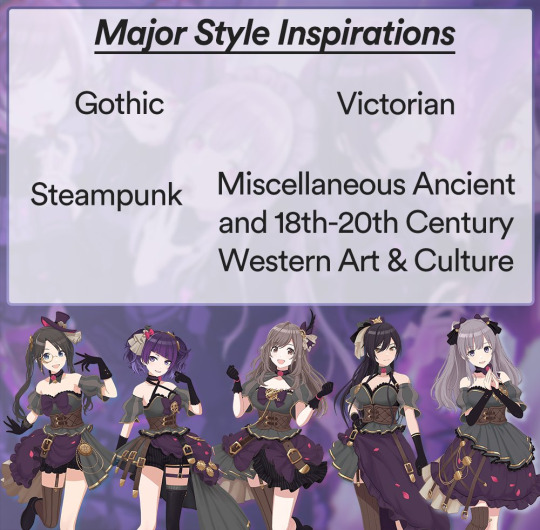
Rather than their costumes having heavy symbolism like illumination STARS, L’Antica’s costumes are more clearly defined by their style inspirations. As per their name, their costumes are influenced primarily by 18th-20th century Western artistic movements.
Gothic refers to an artistic movement around the mid-late 1700s inspired by 12th-century architecture, a popular setting for Gothic fiction. It combines the supernatural, macabre & dark aura of Gothic literature with innate symbolism standing for psychological or social conflict.

The Gothic influence can clearly be seen in their costumes, featuring dark color palettes, Gothic lolita elements like ruffled skirts, and mysterious, sublime settings of supernatural or haunting concepts. Their costumes immerse the viewer in different strange worlds every time.
---
The Victorian Era refers to the period of British culture under the reign of Queen Victoria (1830s-1900s), a popular historical aesthetic due to its iconic upper-class fashion & culture. It’s also an era of revivalism, related to movements like Neoclassicism & Rococo Revival.

Another revival movement that took place is the Gothic Revival, which brought back Gothic architecture and literature into popular culture mixed with values of sentimentalism. As such, Victorian Gothic art has a preoccupation with tragic beauty and symbology for loss and death.

A handful of L’Antica costumes are very inspired by Victorian-era fashion, culture, and art as well as elements of Gothic Revival; more details will be expanded upon in their individual sections.
---

The most notable aesthetic that L’Antica takes inspiration from is steampunk, a genre of science fiction that imagines an alternate future with heavy use of steam engine or spring power and maintaining of Victorian-era visuals.

Other than their main/first unit costumes being heavily steampunk-inspired, it has heavy theming in almost all of their unit costumes; even their logo is a common steampunk element, a key in the shape of a gear.
Perhaps inspired by the Victorian Era being one of revivalism, a handful of L’Antica’s costumes are inspired by other Western/European historical eras. Additionally, eclecticism was a prominent concept during this time, mixing several stylistic influences to make unique designs.
-----
Symphonic Steam (シンフォニックスチーム)

“Symphonic Steam” is L’Antica’s main unit costume and is the most representative of their concept and aesthetic, featuring heavy Gothic and steampunk motifs. The name references them being a primarily steampunk-themed idol group.

The animation features the five girls inside and outside of a clocktower. The clocktower shares many features with real life Gothic Revival architecture, including steep roofs, pointed arches, ornate & lacey trims, and overall picturesque design.
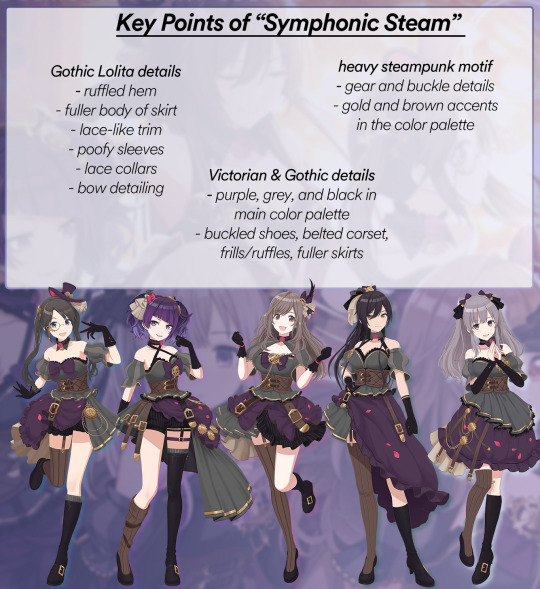
The key points of “Symphonic Steam” are related to its major style inspirations, namely steampunk, Victorian Gothic, and Gothic lolita detailing. As this is their main costume, it greatly encapsulates their main influences and overall dark and esoteric feel of their music.
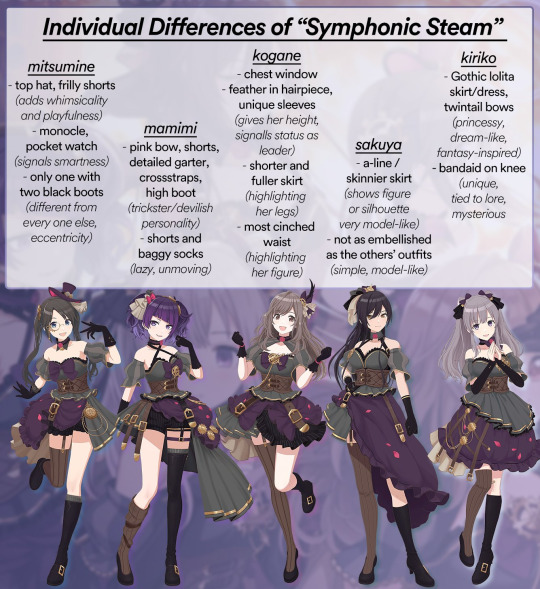
As with many idol costumes, “Symphonic Steam” uses the “similar look” concept to make L’Antica look cohesive & thematically the same while bringing out each of the members’ individuality. This graphics shows some key differences between them, revealing a bit of their character.
Just like their costumes, the animation also shows them in different places or doing different action in/on the clocktower to show off their personalities.
Kgane is center of the clocktower (center/leader), Mamimi is lounging inside (lazy, coy), Sakuya is posing outside (serious, model-like), Mitsumine is on top throwing her pocketwatch (smart, eccentric), and Kiriko is caged, riding to the top (fantastical, dream-like).
---
Faith of Treasure (フェイスオブトレジャー)

“Faith of Treasure” is L’Antica’s second unit costume. Like “Symphonic Steam,” this costume has very heavy steampunk theming. As such, the idols are acting as treasure hunters in an anachronistic Victorian city with steam technology.

Comparing “Symphonic Steam” to “Faith of Treasure,” both costume sport heavy steampunk theming. However, “Face of Treasure” is much lighter and fun in nature, leaning more science fiction/Victorian, while “Symphonic Steam” is dark and moodier, leaning more Gothic.
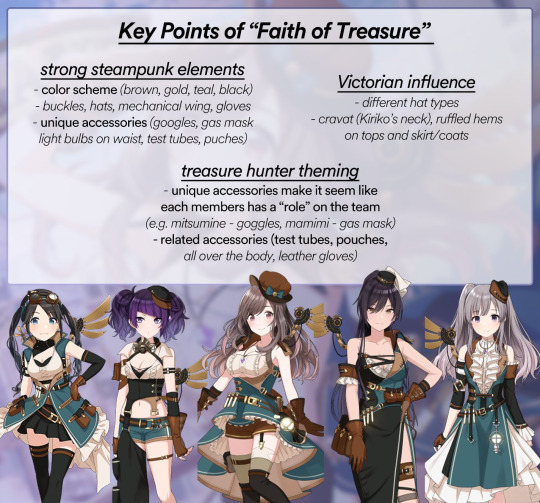
The key points of “Faith of Treasure” are its strong steampunk and Victorian stylistic influence as seen in the graphic. Additionally, the costumes suit their role as treasure hunters with the accessories and accents seen all over their bodies.
Along with the costumes, their animations point to each of the members being in a specialized role in their treasure hunter team.

Mamimi is a thief, having clothes with easy mobility, a gas mask for protection, and running with a bag. Sakuya is a fancy aeronaut with her sleek dress providing little resistance as she flies through the air. Yuika is a pilot or mechanic with her goggles & tinkerer’s tools.
Kiriko is just a citizen as her design is doesn’t have as many details as the other girls, having bourgeoisie details like her cravat & simple dress. Kogane has a gun & a larger sack; along with the items seen in the beginning with the map, she’s probably the leader.
---
La Rosso Grimm (ラ・ロッソグリム)

Translating from Italian to “The Red Grimm,” “La Rosso Grim” is L’Antica’s third unit costume. Taking a step away from steampunk, this costume set is heavily based on Grimms’ Fairy Tales and Gothic fiction.

The setting for “La Rosso Grimm” takes place in a Gothic castle where “five girls are lost,” with the live stage being a replica of the castle and its yard. Gothic castles were a popular setting for Gothic fiction as well as Grimms’ fairy tales due to its mystery & royal nature.
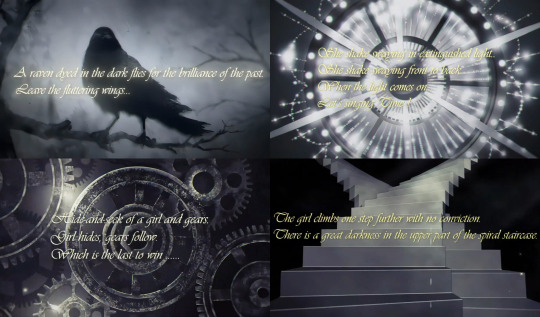
In fact, all of the animations for these costumes have an opening scene that mimics a fairy-tale passage with the mystery and darkness of Gothic fiction. These passages are also directly based off of Grimms’ fairy tales, like “The Raven,” “Snow White,” and “Cinderella.”

However, the biggest fairy tale influence that “La Rosso Grimm” uses is “Little Red Riding Hood.” Besides the obvious name allusion (“The Red Grimm”), the costumes have a hood, the setting is a castle in the tangled woods, and the members pose with wolves in their album cover.

Key points of this costume include steampunk elements as usual (but moreso as accents), a heavier Gothic and punkish influence, and “Little Red Riding Hood” theming in their construction and details.
-----
GO HERE FOR PART TWO (i hit picture limit)
#imas#idolmaster#shiny colors#the idolmaster#idolm@ster#fashion#jfashion#l'antica#kogane tsukioka#mamimi tanaka#sakuya shirase#yuika mitsumine#kiriko yukoku#scfa
6 notes
·
View notes
Text

Late Victorian era corner store c.1886. Apart from the signage, some things don't change. Glebe.
#corner store#facade#24/7#shop#vintage#1880's#late 19th century#late victorian era architecture#awning#streetscape#it's a sign#street scene#unchanged#inner west sydney
231 notes
·
View notes
Text
I'm writing about this in a separate post so as not to add to an already very long discussion, and it just occurred to me that I still haven't got around to writing about Lucy's social class like I said I would at someone's request, but I just wanted to note out that there are a number of details that point to the Westenras being an upper-class family in decline, albeit more lower untitled gentry than peerage like the Holmwoods, and I'm not going to get into all of that right now, but I wanted to highlight this one passage from Seward's diary on September 22:
And now we are all scattered; and for many a long day loneliness will sit over our roofs with brooding wings. Lucy lies in the tomb of her kin, a lordly death-house in a lonely churchyard, away from teeming London; where the air is fresh, and the sun rises over Hampstead Hill, and where wild flowers grow of their own accord.
Someone correct me if I'm wrong, but an ancestral tomb for generations of a family during this time period would be an upper-class practice, and it's something Charles, 9th Earl Spencer (ie. Princess Diana's brother) mentions in an article about the English aristocracy's decline; my understanding is that during the Victorian era, there was a rise in newly rich people who were not aristocrats commissioning elaborate funerary architecture, but in this context, and given later descriptions where the tomb is obviously old and falling apart despite its lordliness - perhaps as a reflection of the Westenra family's decline and fall, as well as arguably that of the aristocracy to varying degrees starting in the late-19th century - Lucy was almost certainly laid to rest in an old family tomb for an old gentry family.
54 notes
·
View notes
Note
i remember you saying that you did a lot of research for gfs, and lately i've been thinking of writing a more historical story so i was wondering if you had any tips for thoroughly researching a specific time period? literally anything will help, i'm horrible at research lol
i have a normal and logical level of love for research. I am not absolutely gleeful over this question to an amount far higher than normal. i am NOT--
yeah no i love this question
SO. I am going to answer the question that writers everywhere cry themselves to sleep over (probably) (maybe)
How The Fuck Do I Research Stuff For My Story? (Specific Time Period Edition)
1: know it's not just one thing.
you're not just "researching". That's a big, big umbrella that holds a LOT of things inside of it. You're researching clothing, politics, economic state, government, food, weapons, societal values at the time, and significant going-ons, among other things. It's better to break that into pieces than to try and tackle "research" as a whole.
Also: HAVE A RESEARCH DOCUMENT. Seriously. Write down anything that could be relevant. Also, have a table of contents or something similar and keep it organized. It helps, trust me.
2: Now, here's your pieces. Go in order.
1) ERA IN GENERAL.
So, you've told me (thanks to my frantic asks to you) that your story in particular is around the 1880s-1900s and takes place in the USA, Britain, France, and Japan. That means your story will exist in the gilded age (rich people! but also poverty), the very end of the Victorian era (she lived so fuckin long bro), the formative years (wooo France is full of communists) and the Meiji period (Japan gets to be powerful!).
No but really you picked a bunch of very.... interesting eras to collide all at once in your story skdjfskjfhk
In general, when it comes to researching the era, you want to look at the big picture of what was going on. You can first search "what era was [time period] for [country]", and then once you have the name of it, go wild: e.g. with the gilded age, you can go "advancements in the gilded age" "politics in the gilded age" "social issues in the gilded age" "the gilded age", and so on and so forth. Put the era's name in your search and you'll find results a lot quicker.
Era will include the economic state, political state, significant historical events before/after (aka events that have influenced your age or that are being influenced by your age), what the era is generally known for, advancements at the time, and relationships with the other countries your story is focusing on.
2) EVERYDAY THINGS AND/OR VERY IMPORTANT THINGS.
Food, fashion, common jobs, family structure, architecture & buildings, societal views, and other things that are addressed almost every day in some way. This is where you want to take the societal positions of your characters into your mind; a poor Jewish immigrant man and a high-class young white woman are going to have very different lives, even if they both live in NYC in the USA's Gilded Age. They'll eat different food, wear different clothes, be expected to have different skills, have different cultural beliefs/practices, have different jobs, and likely have very different political views.
So, when looking things up, think whether or not your characters would actually have that in their lives. There are people in ballgowns and people in rags, and you've got to figure out which one your character will be wearing.
Don't just research something like "1890s clothing". You want to find what is worn in that age by the types of people your characters are. So, "what did people wear in the victorian era" is a bad thing to google and expect precise results. "what did poor men wear in the victorian era" is a lot better.
Now's the time to do your research for some really big things, too. Say you have a scene that happens in a mansion in America, and it's a SUPER IMPORTANT SCENE. You're going to want to look up what American mansions in the Gilded Age often were like beforehand, even if none of your characters live in one or will have seen one beforehand.
3) MUCH MORE SPECIFIC THINGS.
Ok, so you know what a rich woman in the Meiji period would wear every day. Cool. But do you know what she should be wearing in that one scene with the super fancy event? Do you know what music would be playing? Do you know what weapon she could best have in that event?
It's ok if the answer is "no", even after your general research. Specific research is best saved for when you have to know it. Getting bogged down in research is a real thing, and it's very, very frustrating. So, either look those details up when you outline the scene (if you outline it) or when you actually need to write it. Like, say your characters end up in Paris in 1888 for a scene or two. Well, that's when the Eiffel Tower was built! You knew that already, because you looked up 1880s-1900s France and know quite a bit about it!
... what you don't know yet is what the construction site of the Eiffel Tower looked like. And that's fine--it's until it's time to actually focus on that scene.
3: Make Sure Your Sources Are Legit.
This can be hard, but in my experience, good sources will 1) list their sources and not try to hide them or just not have any, and 2) their information will agree with the info in other good sources. Basically, if 4 sources say XYZ and 1 says ABC, you can probably believe that ABC is wrong.
(Reading published books can help with this, though they're not always true, either. Basically: compare, compare, compare.)
4: Know This Takes Time.
It's ok to look at this and go "haha.... maybe I won't write anything historical". It's daunting! It can be a lot!
But it's all just pieces.
You read a couple articles and watch a video about clothing worn by Japanese peasants. You borrow a book that talks about food in the Gilded Age. You get lost down the rabbit hole of Victorian high-society politics. You write it all down in that trusty research doc.
And suddenly, you KNOW THINGS. You know things!! And videos that hinted at X but didn't quite talk about it lead you to researching X, which hints and Y and leads you to research Y, and so on and so forth.
It takes a long time, definitely. You'll be researching before you write, while you outline, and when you're writing. You'll research when you're editing and rewriting, too. But even if you don't particularly like it, you can find comfort in the fact that it just involves searching the right phrases and sitting down to watch some videos or read a library book. And in the end, you'll have a well-researched story--and that info doesn't go away! If you ever have to know something about the Victorian age, you'll be able to look back at what you learned awhile back. (Especially because you have your research doc, right?)
5: TLDR.
know research isn't just one clump, it's a lot of different things you look at
research the era, then general things, then things you need to know in specific situations only
use specific phrases, not just general things; "what jobs did men have in France in the 1880s" is lots better than "French jobs"
make sure your sources aren't just people lying on the internet for fun. comparing what your sources say and using a lot of them can help with this!
know it takes time, but don't stress. You don't have to get it done all at once.
have your motherfucking research doc. are you listening to me. WRITE DOWN THE INFORMATION THAT YOU FINDDDDDD
OK. This was a SUPER long post, but!! I really hope it's helpful!! If you have more questions, feel free to ask away :D
#researching#writblr#writeblr#nico yells writing advice into the void#long post#asks#luce!#i am. so sorry#i cant shut up </3
99 notes
·
View notes
Video
Why Archaeologists Are Fuming Over Netflix’s Ancient Apocalypse Series
https://hyperallergic.com/791381/why-archaeologists-are-fuming-over-netflixs-ancient-apocalypse-series/
In November 2022, Netflix launched a new “docuseries” titled Ancient Apocalypse, presented by journalist Graham Hancock. Over the course of eight episodes, Hancock revivifies long-discounted, Victorian-era views of the ancient past in connection with a great flood and even Atlantis. He also questions the views and motives of professional archaeologists. Hancock’s unfounded hypotheses and attempts to undermine the field of archaeology have now pushed the Society for American Archaeology (SAA) to issue an open letter decrying the show’s disparaging remarks against archaeologists and calling out the show’s alignment with racist theories about the ancient past.
To many, pseudoarchaeology at first appears to be a harmless form of entertainment consumed in jest or by those who revel in tales of lost cities or alien architects. But the recasting of science fiction as historical fact has real consequences. It emboldens conspiracy theorists who then use it to question everything from the legitimacy of the cultural heritage of Indigenous peoples, to scientific studies, to the validity of higher education in general. In remarks to Hyperallergic, Ancient Near Eastern and Egyptian archaeologist Vivian A. Laughlin noted that although archaeology is a social science, “both the social and scientific aspects are consistently disregarded in pseudoarchaeology.” She and many other professional archaeologists have co-signed the SAA letter’s categorization of the show as “harmful” and rooted in “racist, white supremacist ideologies,” adding that it “does injustice to Indigenous peoples; and emboldens extremists.” Finally, they called on Netflix to reclassify the series as “science fiction.”
What exactly does this “docuseries” pose that has archaeologists up in arms? In Ancient Apocalypse, Hancock first positions himself as a truth-teller while often reusing theories from the late 19th century. This includes discredited ideas such as those posited by politician and novelist Ignatius Donnelly in his 1882 book Atlantis: The Antediluvian World. The book argued that the advanced peoples of Atlantis revealed the secrets of architecture and agriculture to Indigenous peoples. Critic of pseudoarchaeology Jason Colavito has written extensively on Donnelly’s use of Atlantis’s utopian society to critique Reconstruction-era America, all while also reinforcing white supremacy: “Atlantis reflected his ideal American society. Whites ruled, of course, but everyone had a share.” Hancock’s resuscitation of Donnelly breathes air back into ideas and ideologies that, as I have written on prior, are rooted in white supremacy.
Although never trained as an archaeologist, Hancock also scripts himself as the truly reliable narrator who can speak out only because he exists outside of “mainstream archaeology.” It is the same outsider approach taken by showmen like Alex Jones or fellow pseudo-archaeologist Erich von Däniken, both of whom bank on public distrust surrounding science and, increasingly, the conservative suspicion surrounding academia itself. Hancock believes that archaeologists have ignored or even covered up the existence of an “advanced Ice Age civilization.” According to his hypothesis, this innovative culture was wiped out around 12,900 years ago by the impact of a comet that then caused a devastating flood. Hancock notes we have been “lied to by academia for eons” about the existence of this advanced civilization.
Hancock has been peddling these goods in print for a long time. In his 2015 book, Magicians of the Gods, a sequel to his 1995 Fingerprints of the Gods, he elaborated on a theory from a 2007 study that originally proposed to explain evidence for large-scale extinctions of megafauna in North America using a comet impact. Hancock then universalized this theory and used it to explain the existence of his “advanced” civilization globally. But as Michael Shermer reported for Scientific American over five years ago, not only is there no crater to support this theory, but the radiocarbon dating does not support a unitary event. This comet also conveniently wiped out all evidence of Hancock’s global, advanced civilization except certain sites which show signs of survivors from Atlantis. Explaining the giant stone pillars of Göbekli Tepe in Turkey as the product of some of these survivors robs Neolithic hunter-gatherers of their agency and ability to create their own monumental structures. As Shermer notes, what Hancock counts on when explaining this mysterious, progressive civilization is the “bigotry of low expectations.”
Contrary to Hancock’s depictions of it, archaeology is today an active field predicated on painstaking excavation and the collation and careful analysis of archaeological data. It is also one which relies on public trust in the science and scientists that undergird it. Active movements led by archaeologists in the SAA and the Archaeological Institute of America (AIA) have encouraged repatriation and set strong ethical codes for the field. Although movies like the recently-revived Indiana Jones series or Tomb Raider may cast looting as archaeological science, professional archaeological sites uncover, document, and map sometimes only centimeters per day. The field is unique in that it is also dependent upon public knowledge and media attention in order to survive. This is true both in terms of external grant funding for digs and, in the case of sites like Pompeii, Petra, or Chichén Itzá, the money that comes from archaeological tourism. In short, archaeologists need and deserve the trust that Hancock denies them. It may be amusing to believe that academics have joined forces to keep secrets from the public, but honestly, they would be the first to tell the world of such findings.
Beyond the SAA, there are also many individual academics countering Hancock’s false narrative. One of the most longstanding and widely read archaeologists today is Eric H. Cline, a professor of Classical and Ancient Near Eastern Studies and of Anthropology at George Washington University, who is also the director of the GWU Capitol Archaeological Institute. In addition to continued excavations at Tel Kabri (Tell al-Qahweh in Arabic) in Israel and his previous work at Megiddo — the site where the Book of Revelation foretells that the final battle of Armageddon will take place — he has written extensively on the biblical archaeology behind ideas of the Apocalypse and on the truth behind the “Sea Peoples” alleged to have invaded Egypt in the Late Bronze Age. In remarks to Hyperallergic, Cline notes that there is simply no proof or supporting evidence for an advanced but now lost Ice Age civilization. Rather than presenting much hard evidence, Hancock presents his audience with a flurry of questions (“Is it possible?” or “Could there have been?”). Cline underscores that the inception of doubt in the minds of the viewer often becomes more important than the presentation of facts.
Hancock’s questions and continued jabs at archaeologists throughout the Ancient Apocalypse series is, as the public SAA letter responds to, a tactic for undermining science and scientists who have dedicated their lives to archaeological inquiry. And such questioning is certainly on trend. Cline notes that the show capitalizes on an anti-establishment sentiment all too common since the 2016 presidential election.
“He is appealing to a particular subset of the general public who are now ‘anti-expert’ (on any topic ranging from medicine to archaeology), building on sentiments which came to the fore during the Trump era and continue today,” Cline said. “Ironically, however, he is beholden to the very archaeologists whose work he denigrates, for almost nothing of what he covers or says in the series could have been done without their work and by standing on their shoulders.”
Perhaps two of the most vocal critics of Hancock in print and on Twitter are archaeologists John Hoopes and Flint Dibble. In comments to Hyperallergic, both pointed to the holes and harm inherent in Ancient Apocalypse. Hoopes points out that in proposing an ambiguously “advanced” civilization, Hancock oddly also requests the audience view it as a society comparable to that of 19th-century Europe. Using European society as the standard metric for intellect, the arts, and “civilization” is at the heart of arguments in favor of white supremacy and European exceptionalism. Dibble similarly points to the fact that claiming such an advanced civilization actually built famed monuments suggests that a “fake civilization is responsible for monuments and the domestication of plants and animals around the world, with the implication that Indigenous people were not responsible for it.”
How did such a sham of a show get made? Is nepotism the answer? Graham Hancock’s son, Sean Hancock, is an executive at Netflix who works in the “Unscripted Originals” department. If you can’t get a show greenlit on its own merit, why not have your son help it along? Nepotism in the art world, in show business, in “legacy” college admissions, and in virtually every other area of our society means that access is often granted to those with more connections than merit. Although there has been intense interest devoted to the so-called nepo-babies that have pervaded the news towards the end of 2022, we might do well to do a bit more investigation into nepo-parents.
Social media plays a big part in the reception and impact of shows like Ancient Apocalypse. In 2022, former Cornell University undergraduate Angelina Nugroho published a network analysis of the Twitter discourse surrounding pseudoarchaeology. What she discovered is that such tweets “employ anti-institutional sentiment and draw on rhetorical themes in support of a historical white supremacy.” Nugroho noted that not only do pseudarchaeological theories and their diffusion detract from the ability of archaeology to provide a general understanding of the field as a scientific field, but they also cause real harm to modern Indigenous populations by undermining their past.
Can we then blame archaeologists for trying to push back against fiction masquerading as fact? As Hancock himself notes, his team was banned from filming at Serpent Mound in Ohio for attempting to falsely modify the dating of the site much earlier, to around 11,000 BCE. In fact, sacred mounds were made by two Native cultures: the Adena culture (800 BCE–100 CE) and the Fort Ancient culture (1000–1650 CE). Beyond shutting gates, other archaeologists are increasingly taking to public scholarship to push back against the broader harms of all “alternate history” shows. Whether it is actress Megan Fox’s short-lived “alternative history” show (inspired by her beliefs that the Pyramids of Giza were actually a kind of ancient power plant) or the lure of former Fear Factor and comedian Joe Rogan’s popular podcast, which Hancock appeared on: Conspiracy theories and pseudoarchaeology are a growing business.
The SAA letter points to the fact that every day, thousands of archaeologists work to speak to the public in museums, through government agencies, in university courses, on dig sites, and through their publications. Amplifying a culture of distrust around these professionals causes harm not only to them and to cultural heritage institutions, but also damages attempts at understanding and celebrating Indigenous peoples across the globe. At the end of the day, archaeologists are translators and, as Cline notes, “The number one danger is that such fantastical work, presented without supporting evidence, targets gullible audiences, who don’t know who or what to believe.”
While pseudoarchaeological shows are growing on the History network and now Netflix, the number of fact-based documentaries focused on the archaeological process and the science behind it is on the decline in the United States. As an increasing number of series get canceled across HBO, Netflix, and many other streaming services, opportunity is now at a premium. And championing pseudoarchaeology often means that the shows that center science are not given the green light. What might be the solution here? The SAA and many others see equal air time as one way forward. Cline notes that “the general public has seen only Hancock’s version in this series; a response by professional archaeologists, even of only an hour, and broadcast by Netflix, would be most welcome.” If Netflix is truly invested in presenting historical fact, it might do well to set a policy of allowing archaeologists to have their own shows with ample time to respond. Make no mistake that they will show up with trowels and real evidence in hand.
#tiktok#Ancient Apocalypse#netflix#Archaeologists#racism#archaeology#archaeological#ancient history#history#article#Hyperallergic
18 notes
·
View notes
Text
I think the thing I always find interesting when I think about Jack's familial home — i.e. the house he spent those first few years in on Shipwreck Cove both prior to and in the immediate aftermath of his mother's death at the age of seven — is that from the way that Jack pictures and describes it, it really ought to be some kind of abandoned, haunted Victorian manor, lost to time.
the reality is that this house is on Shipwreck Island in the late 17th / early 18th century, which is implied to be either in the Caribbean or somewhere off of the coast of South America. a lot isn't really known, at least by Jack in TPOF, about the origin of Shipwreck; there are rumours that it dates back to Ancient Greece, but that seems unlikely imo. it's much more likely that the architecture of this manor more accurately resembles either the British or Spanish colonial-era architecture of the surrounding territories that either Britain or Spain colonised ( assuming that the British or Spanish arrived on Shipwreck Island first ), or the plantation style houses of Jamaica and other Caribbean islands, since this manor is certainly set apart from the smaller homes in Shipwreck City. either way, the house is large, light, bright, spacious and conveniently located in paradise, which is such a beautiful juxtaposition to the dark, twisted way in which Jack perceives it based on his lived experience
#&. he plays things closer to the vest now ( headcanon. )#i'm sure i can summon hannah to this post and offer expertise in terms of shipwreck architecture lmao#but it's a beautiful house. let it be known#but frozen in time. jack's bedroom is still there as he left it when he was nine#all of the things he hid beneath the floorboards are still there#jack won't return there except under extreme duress#because he would be stepping back into that extremely painful and lonely part of his childhood
7 notes
·
View notes